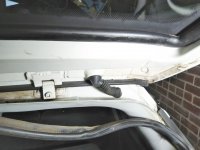Hi all
I have a 1992 505 GTi wagon and the rear window demister/defogger does not work.
I'm guessing this is normal for the car's age, but was wondering what other people have experienced.
It hasn't worked since I got the car about 7 years ago, but today I decided to have a closer look using a multimeter and I discovered that every trace was broken in at least one place if not multiple places. The breaks were so small I couldn't actually see then. It is consistent with the traces shrinking and creating tiny cracks that break the circuit, maybe due to shrinkage, but that is speculation.
So what do people do to get it working again?
Repair each tiny break - but it seems more tiny breaks would likely occur over time.
Replace the entire grid? I found a company in the USA here: https://frostfighter.com/how-to-replace-defroster-gridlines.htm
Can the old grid lines be removed?
Thanks in advance for your thoughts,
Hugo
I have a 1992 505 GTi wagon and the rear window demister/defogger does not work.
I'm guessing this is normal for the car's age, but was wondering what other people have experienced.
It hasn't worked since I got the car about 7 years ago, but today I decided to have a closer look using a multimeter and I discovered that every trace was broken in at least one place if not multiple places. The breaks were so small I couldn't actually see then. It is consistent with the traces shrinking and creating tiny cracks that break the circuit, maybe due to shrinkage, but that is speculation.
So what do people do to get it working again?
Repair each tiny break - but it seems more tiny breaks would likely occur over time.
Replace the entire grid? I found a company in the USA here: https://frostfighter.com/how-to-replace-defroster-gridlines.htm
Can the old grid lines be removed?
Thanks in advance for your thoughts,
Hugo

